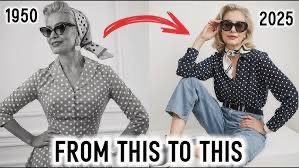


14 August 2025
Women’s
Lifestyle
14 Aug 2025
Women’s
Lifestyle


A Women’s Life
Here’s a comprehensive comparison of women’s lives in Australia in the 1950s versus 2025, focusing on key areas such as family roles, education, work, rights, health, and social expectations. It reveals an extraordinary transformation from a highly restricted and traditional role for women to one of expanded choice, autonomy, and complexity.
Category 1950s Australia 2025 Australia Family Role Homemaker, mother, dependent on husband Equal partner, co-provider, diverse family choices Work Limited to nursing, teaching, clerical jobs Present in all sectors: politics, STEM, business Education Few attended university; early school leavers Higher education majority; outperforming men Legal Rights Couldn’t get equal pay; limited rights post-marriage Full legal equality; paid parental leave, property rights Mental Health Rarely discussed, postpartum issues taboo Acknowledged and treated; maternal health support Sexuality Repressed, little sexual autonomy Greater freedom, access to contraception, open discussion Politics No real power or representation Growing leadership roles, legal protections Technology Home appliances revolution just beginning Tech-empowered: digital lives, careers, safety tools Relationships Marriage expected young; divorce rare Marriage optional; diverse relationships accepted Social Expectations “Good woman” = wife and mother “Good woman” = independent choice; identity fluidity
A woman’s primary role was to marry young, have children, and be a homemaker.
Single mothers were heavily stigmatised.
Women were expected to support their husbands’ careers and not pursue their own.
Contraception was limited; families were often large and unplanned.
Women choose if and when to have children.
Co-parenting, single motherhood, IVF, adoption, and child-free lifestyles are common and accepted.
Same-sex couples and solo parents are legally protected.
Household responsibilities are more equally shared (though not always evenly).
Shift: Family life is now shaped by women’s choices—not defined by rigid gender roles.
Married women were often barred from full-time work (the “marriage bar”).
Jobs were gender-segregated: teaching, nursing, secretarial work.
Unequal pay was the norm.
Women were expected to leave jobs upon motherhood.
Women participate in all industries, from mining to tech and politics.
The gender pay gap still exists but is narrowing.
Workplace protections (e.g., parental leave, anti-discrimination laws) are in place.
More women are starting businesses, becoming CEOs, and leading in STEM fields.
Shift: Women are essential to the workforce, though glass ceilings and gender inequality persist in some sectors.
Most girls left school early to prepare for marriage or basic jobs.
University was rare for women and limited mostly to “feminine” disciplines.
Little encouragement to pursue ambitions beyond the home.
Girls outperform boys in most academic areas.
Women dominate university enrolments across many fields.
Girls are encouraged to pursue STEM, entrepreneurship, and leadership from early schooling.
Shift: Women now have more access to education than ever—leading to greater independence and opportunity.
Women needed their husband’s permission to open a bank account or obtain birth control.
Domestic violence was not widely recognised or legally addressed.
Sexual harassment was ignored or blamed on women.
Feminist voices existed but were marginalized.
Women have full legal autonomy.
Anti-discrimination laws, domestic violence protections, and workplace rights are in place.
The feminist movement has evolved to include intersectionality, race, class, and LGBTQ+ rights.
Consent, equality, and bodily autonomy are widely discussed.
Shift: From legal dependency to full citizenship with rights—though enforcement and societal attitudes still vary.
Contraception was difficult to access; abortion was illegal.
Reproductive health was shrouded in shame.
Postnatal depression and menstrual health were misunderstood or ignored.
Male doctors dominated the medical field.
Women can access contraception, safe and legal abortion, and IVF.
Mental health support for postnatal issues is growing.
Female doctors, specialists, and leaders in healthcare are common.
Public awareness of reproductive health is stronger (though rural and Indigenous access still faces gaps).
Shift: Women are reclaiming autonomy over their health and bodies—but inequity still exists in practice.
Women were expected to be virgins at marriage; sexuality was repressed.
Divorce was difficult and shameful.
LGBTQ+ identities were illegal or considered a “disorder.”
Women had little protection from marital rape (which wasn’t criminalised until 1991).
Women date, marry, or remain single by choice.
Divorce and de facto partnerships are common.
LGBTQ+ women can marry, adopt, and live openly.
There’s public discourse around consent, sexual autonomy, and pleasure.
Shift: Sexuality is no longer defined by shame or patriarchy. Women have increasing control over their own sexual and relationship lives.
“Hysteria” and institutionalisation were common labels for women’s distress.
Mothers were blamed for psychological issues in children.
Female identity was reduced to domestic function.
Mental health is openly discussed, with specific services for women.
Social media, though often problematic, has given women voices and networks.
Women speak out about trauma, abuse, and mental illness through activism and storytelling.
Identity is self-defined—not imposed.
Shift: Mental health is treated more holistically, and women’s voices are heard across platforms and professions.
Fashion, behaviour, and appearance were strictly policed.
Women couldn’t go to the pub alone, and social life was male-dominated.
Leisure options were limited and often tied to the family.
Women travel alone, lead social movements, play sports, game, and start businesses.
Fashion, beauty, and expression are diverse and self-driven (though still commercialised).
Self-care, fitness, and independence are part of modern womanhood.
Shift: Lifestyle choices are wide open, with less judgment—though social media and consumerism create new pressures.
Women had only recently won the vote (federally in 1902, but in practice many barriers remained).
Female MPs were extremely rare.
Politics was a male preserve.
Female premiers, ministers, and activists are prominent.
Parliament is more gender-balanced than ever before.
Women’s issues are political issues: childcare, climate, health, safety.
Young women lead online campaigns, climate protests, and justice movements.
Shift: Women are power holders, not just voters. Political leadership is increasingly diverse and inclusive.
Technology was mostly for men or confined to domestic appliances.
Safety depended on family or community norms.
Women use technology for career, connection, education, and activism.
Apps for personal safety, tracking, period tracking, and mental health are widely used.
Social media is both empowering and threatening (cyberbullying, image-based abuse).
Online activism has sparked major movements like #MeToo.
Shift: Tech empowers and endangers—offering tools for freedom and forums for abuse.
In the 1950s, women’s lives in Australia were defined by dependence, silence, and social conformity. By 2025, women’s lives are marked by choice, voice, and complexity. While many struggles remain—especially for women of colour, Indigenous women, women in rural areas, and those facing economic hardship—the landscape has transformed.
From homemaker to changemaker
From silent sufferer to outspoken advocate
From dependent spouse to independent citizen

Crawler Crane Operator
1986 Started off working at New Oakliegh Motors as a new car Detailer. Then 1987 completed becoming a flying instructor course at Civil Flying School Moorabbin. In 1991 worked at Dial a Transport as a truck driver. Then in 1994 I purchased a truck and worked as a subcontractor for Westfi, Amerind then Glen Cameron’s Transport. In 2000 purchased a crane truck and started Powerful Crane Trucks built that up and was sold in 2017. In 2018 started Compact Crawler Cranes
Are you sure want to log out?
Allowed image types: JPG, JPEG, PNG, and WEBP
Allowed image types: JPG, JPEG, PNG, and WEBP
Allowed video types: MP4, MOV, and WEBM.